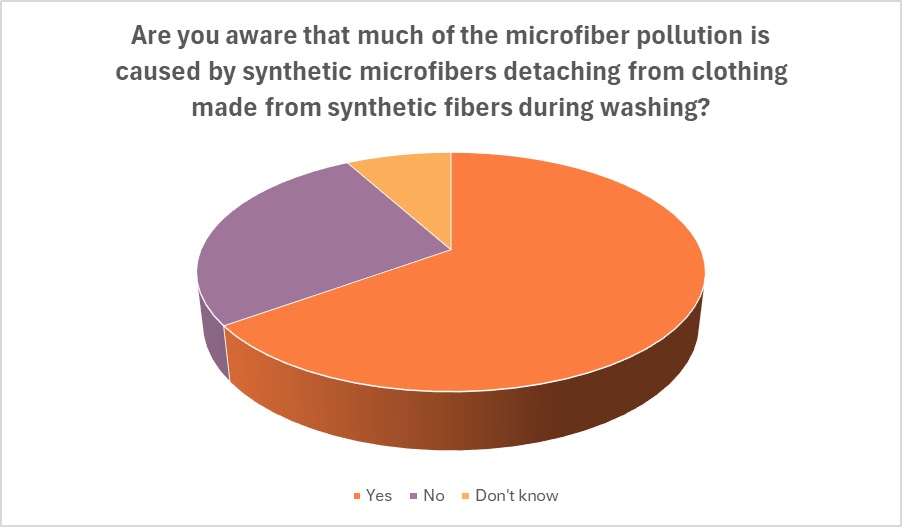Amazon recently announced it has replaced 95 percent of the plastic pillows used for packaging in the U.S. and plans to phase them out entirely by the end of the year. The move comes as more consumers say they are somewhat or very concerned about microplastics and the repercussions they have on human health. In the fashion sector, microplastic pollution stems from petroleum-based fabrics such as polyester, nylon and acrylic. And like Amazon, there is something apparel brands can do to change course for the better.
Designing with natural fibers, like cotton, is one of the key strategies to reduce plastic leakage from the apparel industry.
Dr. Jesse Daystar, Vice President & Chief Sustainability Officer, Cotton Incorporated
Amazon’s announcement preceded the kickoff of Plastic Free July, an initiative of the Plastic Free Foundation whose mission is to work toward a world free of plastic waste. In the fashion sector that comes down to reducing the use of petroleum-based textiles like polyester. That’s because synthetic textiles like polyester shed tiny microplastic particles, whether during wear or through laundering, adding to the planet’s microplastic pollution problem.
In a recent American Apparel & Footwear Association webinar, Dr. Partik Ichhaporia, vice president of technical services, North America, for Eurofins MTS, a consumer product testing firm, explained the microplastic pollution from textiles is poised to grow significantly by 2030 unless there is a sea change within the fashion industry.
“Just the global apparel consumption could increase by as much as 63 percent, so you’re not really reducing our use of the textile materials overall,” Ichhaporia said. “And the proportion of the polyester tends to be increasing as compared to other fibers. We are increasing the consumption and also the proportion of the synthetics, especially polyester, which seems to be the primary microparticle that will be increasing. So, this is a challenge or a problem that we need to be aware of and start addressing.”
It seems apparel shoppers would appreciate if the fashion industry took up this issue, as well. Nearly half of all consumers (45 percent) say they are aware of current concerns about clothing microfibers polluting our oceans and waters, according to the Cotton Incorporated Lifestyle Monitor™ Survey. Of those who are aware, 65 percent know it comes from clothing made from synthetic fibers, especially during washing. A single load of laundry could release 700,000 microplastic fibers, which wind up in waterways, food supplies and drinking water.

This concern about microplastic pollution from synthetic apparel carries over to what consumers want to purchase. The majority of consumers (70 percent) say their awareness of microplastics factors into the clothing they buy, according to Cotton Incorporated’s 2022Laundering & Microplastics Survey. Further, the majority of moms and dads (61 percent) agree they would prefer their children wear clothes that do not create microplastic pollution, according to the Monitor™ research.
The awareness of microplastics is having an impact on consumer behavior – 73 percent of consumers say their awareness factors into how they do their laundry. Out of those 73 percent, most consumers (51 percent), say they purchase clothing and textiles made of natural fibers to reduce microplastic pollution from synthetic apparel, according to the 2022 Laundering & Microplastics research.
And when it comes to sustainability, 75 percent of consumers say it is important their apparel be made from materials that can biodegrade, according to Cotton Incorporated’s 2022 Apparel Sustainability and Back to Office Study.
“[Sustainability means] natural fibers and materials used from the environment. Ones that are easily collected and gathered without harming animals or agriculture,” according to a response in Cotton Incorporated’s 2023 Global Sustainability Study, U.S.
And that’s where the difference between a natural fiber like cotton and a synthetic, petroleum-based textile like polyester stands in sharp relief. Research conducted by North Carolina State University, shows that when cotton and polyester were put in wastewater for 32 days, 94 percent of the polyester remained, while just 8 percent of the cotton remained. In fresh water, 100 percent of polyester remained, compared to just 21 percent of cotton.
The situation is the same when apparel was put to degradation tests in soil. After 90 days in a compost, a cotton shirt saw 78 percent decomposition versus 18 percent for a polyester shirt.
But microplastic fibers are not only in water and soil. The particles blow through the air and are found in crops, too. The microplastic fibers have entered the food chain, are in our drinking water and enter our respiratory systems. Research is showing microplastics can “cause a variety of human health concerns, including neurotoxicity, dermal irritation and organ inflammation,” according to SGS (Société Générale de Surveillance), a global inspection, verification, testing and certification company.
Recent research published by Cotton Incorporated highlights the significant environmental impact of synthetic clothing, which generates 7.4 million tons of plastic pollution annually. This pollution is equivalent to the weight of 820 Eiffel Towers. The study underscores the apparel industry’s role in contributing to plastic leakage, with synthetic garments being a major culprit.
“The impact of synthetic garments on plastic pollution is staggering, with at least ten times more leakage than cotton clothing,” said Jesse Daystar, Ph.D., vice president and chief sustainability officer at Cotton Incorporated. “Designing with natural fibers, like cotton, is one of the key strategies to reduce plastic leakage from the apparel industry.”
Fashion designers likely wouldn’t want to be seen as playing a part in consumers’ health issues. But the fact remains that most brands rely heavily on manmade fibers, to the point that most apparel (69 percent) is made partially or entirely of synthetic fibers like polyester, which are derived from crude oil, according to EarthDay.org. The group also points out that the average person buys 60 percent more garments than they did 15 years ago, but keeps them for only half as long before discarding them.
Perhaps this is why more than three-quarters of all consumers (77 percent) say they are interested in clothing that is designed with durability (lasting a long time) in mind, according to Cotton Incorporated’s 2023 Circularity Survey. That’s followed by interest in biodegradable clothes that can decompose and return to the earth (65 percent), clothes that can be repaired to extend a garment’s life (68 percent), and apparel that can be composted into nutrient-rich soil (58 percent).
The Plastic Free Foundation says choosing “timeless pieces made from natural fibers is a powerful way to support more sustainability in fashion and reduce microplastics.”
And as Lindsay Miles, educator and author, states, “Plastic Free July is an opportunity not only to look at our own plastic use and make individual changes, but a chance to be part of something bigger – to join with others and belong to a movement leading the way in changing both behavior and policy.”
For more details about the plastic leakage assessment of the global apparel industry,
please read the topline report.
